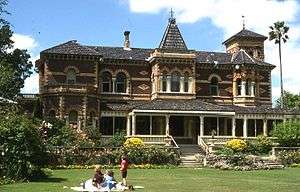Polychrome brickwork

Polychrome brickwork is a style of architectural brickwork which emerged in the 1860s as a feature of gothic revival architecture, wherein bricks of different colours (typically brown, cream and red) were used in patterned combination to highlight architectural features. It was often used to replicate the effect of quoining and also decorate around windows. Early examples featured banding, with later examples exhibiting complex diagonal, criss-cross and step patterns, in some cases even writing using bricks.
Use in England
Nineteenth century English architects such as George Edmund Street and William Butterfield, working in a time of nostalgia for the medieval era, designed many Gothic Revival churches and school buildings, often incorporating polychromy. Art critic John Ruskin, in his book The Seven Lamps of Architecture, used certain Tuscan and Venetian Romanesque and Gothic buildings such as the Doge's Palace in Venice, a famed example of polychromy, as exemplars of the attributes of the movement.
Use in Australia
In Australia it was attributed to architect Joseph Reed, although he may have simply popularised it. The earliest modern example is Lisburn House in Dunedin, New Zealand. The style also emerged in England in the 1870s where examples of it can be seen in the work of William Butterfield (who incidentally collaborated with Joseph Reed on St Paul's Cathedral, Melbourne). Although there are later examples, including the work of Watson Fothergill in Nottingham, however generally it failed to gain widespread acceptance in the United Kingdom.
Rare examples of its use can be found in Sydney, Brisbane, however it is most prevalent throughout Victoria, Australia and the most elaborate examples can be found in Melbourne from the period of the 1880s and 1890s. It was used extensively as a decorative element in "Melbourne style" terrace houses and workers cottages during the 1880s. Many such terraces were later rendered over to hide the polychrome, but some have later been restored to once again reveal the decorative brickwork. It was also used as a decorative in numerous school and church designs throughout Melbourne.
The art of polychrome brickwork was revived for several mock historical commercial buildings and homes in Australia in the 1990s due to its relative ease of application and faithful reproduction in comparison to other mock historical styles.
Examples
Notable examples of its application include:
- Doge's Palace, Venice (1340)
- Château de Blois, Louis XII wing, France
- Lisburn House Dunedin, New Zealand (1865)
- St Michael's Uniting Church, Melbourne (1866)
- St Pancras railway station (1866)
- Keble College, Oxford (1868)
- Rippon Lea Estate Ripponlea, Victoria (1868)
- Royal Albert Memorial Museum, Exeter (1868)
- Cambridge Terrace Carlton, Victoria (1873)
- Royal Institute for the Blind, St Kilda Road (1876)
- St George's Uniting Church St Kilda East, Victoria (1877)
- St Augustine's, Queen's Gate, London (1865)
- Exeter School (1878)
- Boag's Brewery Launceston, Tasmania (1880s)
- Yorkshire Brewery Collingwood, Victoria (1880)
- Holcombe Terrace Carlton, Victoria (1884)
- Rialto Buildings Collins Street, Melbourne (1888)
- Denton Hat Mills Abbotsford, Victoria (1888)
- Templeton carpet factory, Glasgow (1889)
- Old Museum Building, Brisbane (1891)
- Fothergill's Offices, Nottingham (1893)
- Church of England Mission Hall, Melbourne (1894)
- Ascot Vale Presbyterian Church Ascot Vale, Victoria (1897) (destroyed by arson in 2004)
- Westminster Cathedral, Westminster ((1903))
References
External links
| Wikimedia Commons has media related to Brickworks with color patterns. |